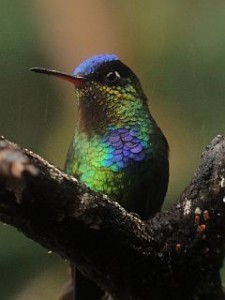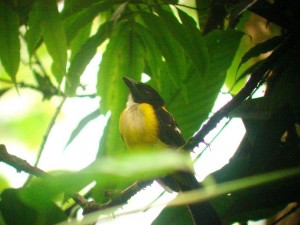Birding hotspots don’t just earn that claim to fame for the bird species that show up. While rarities and high quality species are certainly part of the hotspot equation, other factors also determine a site’s eligibility on the hotspot scale. For example, in Costa Rica, we can surmise that birding in the middle of large national parks like Braulio Carillo, Corcovado, and Tortuguero would probably be one of your more exciting days of Costa Rica birding. However, the inaccessible nature of the core areas of those parks makes them ineligible for the hotspot list.
A hotspot should be relatively easy to get to, host more bird species than other sites or certain rarities tough to find elsewhere, and be consistent with the quality experience it delivers. It’s a bit like a five-star hotel or restaurant- you go there because you expect a certain level of service or experience based on consistently good times had by others, especially when those “others” are experts replete with seasoned knowledge. Carara National Park fits this definition of a hotspot in every sense of the word. Most birders who go there see lots of great birds on every visit, in being located along a main highway, it couldn’t be easier to get to, and you consistently come away from the trails with a fine list of quality species.

Carara is one of the easiest sites for Great Tinamou.
Quebrada Gonzalez also earns hotspot status, albeit a lesser known one on account of the typically challenging birding, especially for tour groups. Many tours pay a brief visit to the place in the hopes of seeing some foothill specialty or catching up with an amazing mixed flock but none stay for the entire day. That’s reasonable given the slow periods and tough forest birding, but walk the same trail twice during a day of birding and you will be surprised at what you find. When I do that, I usually find foothill specialties missed during the morning, run into more mixed flocks, and just see more rare birds in general. It takes time but the birds eventually come out of the woodwork.

The Lattice-tailed Trogon is one of the regular species at Quebrada Gonzalez.
A third type of hotspot is the one that is overlooked. It usually gets passed by because the regular tours either aren’t aware of the birding opportunities or don’t think it’s worth their while. These are the hotspots that are found by local birders because they have the time to check them out on a regular basis and they can be surprisingly close to the San Jose area. One such hotspot is Varablanca and surroundings. Situated on the saddle between the Barva and Poas volcanoes, it’s strategic location on the continental divide and makes for an excellent base to use on a birding trip. The birding potential of the Varablanca area is made apparent when you consider that I routinely get over 100 species on day tours there. The following are some of the other reasons why Varablanca is probably one of the best overlooked hotspots in Costa Rica:
1. Access: Varablanca is on one of the main routes between the Central Valley and the Caribbean lowlands (route 5) and because of this, can be reached by good roads from the San Jose area in an hour or so. Several public buses also use this route. Get there by heading up through Barva and Santa Barbara or follow the signs to Poas Volcano from Alajuela and then follow signs towards Poas Volcano Lodge. When you come to a small gas station with a turn off to Sarapiqui and the Waterfall Gardens, you have reached Varablanca central.
2. Infrastructure: Lodging ranges from several mid-priced cabinas like the cozy and friendly Poas Lodge to more expensive, just as friendly accommodation at the beautiful Poas Volcano Lodge. There are small stores in the area and restaurants include everything from small family diners to Colbert, one of the better French restaurants in the country (yes, it is damn good and very well priced).

The quaint Cabanas Varablanca have good rooms for a great price.
3. Good habitat right around Varablanca: While the immediate habitat around Varablanca might look patchy, don’t be fooled into thinking that the area around your lodging isn’t worth birding. For example, when our local birding club stayed at the Cabinas Varablanca, we were pleasantly surprised by Prong-billed Parbet, Emerald Toucanet, both silky-flycatchers, Spangle-cheeked tanager, Golden-browed Chlorophonia, Ruddy-capped Nightingale-Thrush, Yellow-thighed Finches, and several other cloud forest species in the second growth right behind the cabins. That second growth is connected to better forest in a hidden ravine that is in turn connected to forest on Volcan Barva and I bet it holds a lot more surprises (like the singing Yellow-bellied Siskin I had around there in March).

Chlorophonias are fairly common in the area.
4. A variety of other habitats and birding sites: Don’t just bird around Varablanca. The main reason this area is a hotspot is because it can be used to easily access various quality habitats that host hundreds of bird species.
High elevation forest on Poas is good for Fiery-throated Hummingbird, Yellow-winged Vireo, and most highland specialties including R. Quetzal, Sooty Robin, and may even offer Unspotted Saw-whet Owl.

Fiery-throated Hummingbirds are especially common at high elevations on Poas.
Cloud forest is accessible at sites on the way to Poas. One of the best is at the Volcan Restaurant. Check out the hummingbirds coming to their feeders and watch for a wide assortment of cloud forest species in the middle elevation forest around the restaurant. The place can sees daily visits by Resplendent Quetzal in March and April when the many wild avocados are in fruit.

A Magnificent Hummingbird at the Volcan Restaurant feeders.
Cloud forest can also be birded on the way to Cinchona and has Barred Becard, Rough-legged Tyrannulet, Chiriqui Quail-Dove, and hundreds of other possibilities. The area around the Peace Lodge can be especially good and if you want to pay the $30 entrance fee, you will see some of the best hummingbird action in the country as well as near guaranteed Sooty-faced Finch.

At Cinchona, stop at the Hummingbird cafe for close looks at middle elevation species like Coppery-headed Emerald, Green Thorntail, and White-bellied Mountain-Gem.
Head a bit further down and roadside birding above the Virgen del Socorro canyon can yield fantastic mixed flocks of tanagers, Brown-billed Scythebill, and even rarities like Lovely Cotinga (saw a male there earlier this year, and I routinely get Black-crested Coquette, Red-headed Barbet, Rufous-browed Tyrannulet and other foothill birds).

What the habitat looks like above Virgen del Socorro.
Head into the Virgen del Socorro canyon and you can run into more mixed flocks, might pick up Immaculate Antbird, and have a chance at dozens of quality species including Blue and Gold and Black and Yellow Tanagers.
Keep following the road up out of the canyon, head to the right to pass by the Albergue del Socorro (or stay there) and you can bird in excellent middle elevation forest all the way back up to the village of San Rafael and meet back up with Route 5 maybe 5 or 6 ks before Varablanca. This little-birded road goes through habitat connected to Braulio Carrillo National Park and can probably turn up just about every middle elevation species possible. Some of the extra good birds I have had there during a few visits are Ornate Hawk-Eagle, Brown-billed Scythebill, Lattice-tailed Trogon, and White-crowned Manakin.

Awesome middle elevation forest indeed.
Even the Sarapiqui lowlands aren’t that far away from Varablanca. If you drive straight there, it might take 40 minutes to an hour. The Eco-observatory and Tirimbina are two of the best Sarapiqui birding sites that are fairly close to Varablanca.

Looking for Snowy Cotinga from the Eco-Observatory deck (we saw one).
5. Rarities and quality species: Given that quality high elevation, middle elevation, and lowland forest are all within striking range from Varablanca, there are really too many quality birds to mention. Literally hundreds of species are possible including Great Green Macaw (in Sarapiqui for much of the year and around Virgen del Socorro from at least September to November), Sunbittern, R. Quetzal, Black Guan, various raptors, Bare-shanked Screech-Owl, Bare-necked Umbrellabird, Lovely Cotinga, and loads of hummingbirds and tanagers. Seeding bamboo in 2012 also turned up Barred Parakeet, Slaty Finch, and lots of Peg-billed Finch.

This Black Guan was right on the main road between Varablanca and Cinchona.

Had the spectacular Resplendent Quetzal on most trips to Poas this year.
If you are looking for a great base for birding most elevations on the Caribbean slope, in my opinion, Varablanca is one of the best options. Not to mention, the scenery is pretty nice too.



































